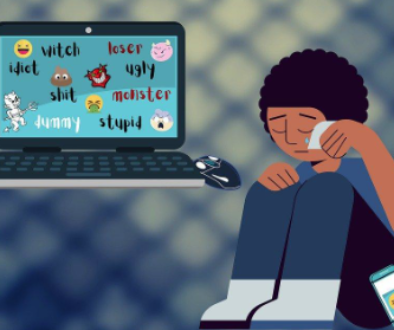Cyberbullying Statistics – How much are Kids being Cyberbullied and in what ways?

As a parent or concerned adult, you are probably aware of the problem of cyberbullying (or online abuse) and how it impacts our children. You could also be seeking answers to the following questions:
- What percentage of kids are victims of cyberbullying?
- How does cyberbullying impact our children emotionally?
- Which countries have the highest rate of cyberbullying?
- Which social media platforms have the worst statistics for cyberbullying?
And so on…
They say that numbers don’t lie. Let’s look at the latest cyberbullying statistics that will answer these questions. So, let’s get started.
How many children have been cyberbullied?
Here are some key findings with regards to how many children have been cyberbullied:
- In 2019, 36.5% of children believe that they have been cyberbullied – while 17.4% have reported cyberbullying in the previous 30 days.
- 60% of teenagers have experienced some form of cyberbullying in their life.
- 70% of teenage children have reported that someone has spread online rumors about them.
- 87% of young adults have seen cyberbullying happening on an online platform.
- Around 37% of young teenagers between the ages of 12-17 have suffered from cyberbullying, while 30% have experienced it more than once.
- 23% of students admit to saying (or doing) a “mean” thing to another online user – while 27% have experienced mean behavior from another online user.
- Around 50% of LGBTQ+ students have experienced online harassment.
- Only 1 in every 10 victims of cyberbullying report their abuse to their parents or any trusted adult.
Cyberbullying is a real threat as 95% of teenagers are connected to the Internet, while 85% are present on social media platforms.
How does cyberbullying impact children emotionally?
Be it any form, cyberbullying is known to harm the emotional health of children and teenagers. Here are some frightening statistics about the emotional impact of cyberbullying:
- 64% of cyberbullied victims say it impacts their ability to learn and feel safe on school premises.
- A CDC study found that cyberbullied students have trouble adjusting to schools, and experience some form of mental health and behavioral problems.
- Cyberbullied students are twice more likely to experience problems like constant headaches and stomach aches.
- A National Center for Education Statistics article found that 19% of cyberbullied students feel this experience negatively impacted their emotional feelings. 14% say cyberbullying impacted their relationship with friends and family members, while 9% reported a negative impact on their school activities.
- After their cyberbullying experience, over 50% of teenagers felt angry, while 33% felt hurt and 15% experienced fear. Two-thirds of cyberbullying victims say that the experience impacted the way they felt about themselves.
- One-third of cyberbullying victims say this incident impacted their friendships, while 13% reported a negative impact on their physical health.
- 68% of children experiencing mental health problems experienced cyberbullying in the previous year.
- 37% of cyberbullying victims have developed depression, while 26% have had suicidal thoughts.
Which countries have the highest rate of cyberbullying?
Cyberbullying is a global problem and is not restricted to a few countries. Here are some alarming statistics about the incidence of cyberbullying around the globe:
- According to parents, the highest instances of cyberbullying happens in India – where 37% of parents have reported that their children have experienced online abuse.
- European countries that are most at risk for online abuse of children include Denmark, the Netherlands, Finland, and Norway.
- 34% of British teenagers have experienced cyberbullying when playing mobile games.
- 15% of American students have reported being cyberbullied.
- Japanese teenagers aged between 12-18 years are likely to have health and social problems after experiencing cyberbullying.
- 17% of U.K-based parents have reported their children being cyberbullied.
- 25% of young people in Russia (aged above 14 years) have been cyberbullied due to their sexual orientation or physical appearance.
Which social media platforms have the worst statistics for cyberbullying?
Social media platforms have the highest incidence of cyberbullying incidents for growing children and teenagers. Here are some cyberbullying statistics that involve popular social media platforms:
- 9% of young adults have posted embarrassing photographs of themselves on social media sites.
- Instagram has the highest incidence of cyberbullying for adolescents at 42% – followed by Facebook at 37%.
- 38% of social media users report seeing instances of cyberbullying daily.
- 95% of teenagers witnessing cruel behavior on social networking sites have ignored the incident.
- 85% of parents of children aged between 13-17 report that their children have an active social networking account.
- Only 1 in 6 parents know about their child being cyberbullied on a social networking website.
What are the statistics for cyberbullying on school premises?
Even with schools imposing mobile phone restrictions on students, cyberbullying continues to persist on school premises. Here are some alarming statistics about cyberbullying in schools:
- 9% of students (aged between 12-17) admit to pretending to be someone else on online channels.
- Cyberbullying is the leading concern for school teachers.
- One in every five students skips school following an incident of cyberbullying.
- 29% of online bullying in schools occurs in the sixth grade.
- Schools with a higher rate of cyberbullying do not allow the use of mobile phones during school hours.
- 11.5% of students (aged 12-17) have admitted to engaging in cyberbullying.
Conclusion
As these statistics reveal, cyberbullying is a growing problem for parents and school authorities all across the globe. As more students go online on social media and gaming platforms, this problem is only likely to become worse. As a concerned parent, you must communicate the harmful effects of cyberbullying to your growing child and how to protect themselves (and others) from its adverse effects.
We hope these cyberbullying statistics are a real “eye opener” and propels concerned adults towards the right action for its prevention and response.



